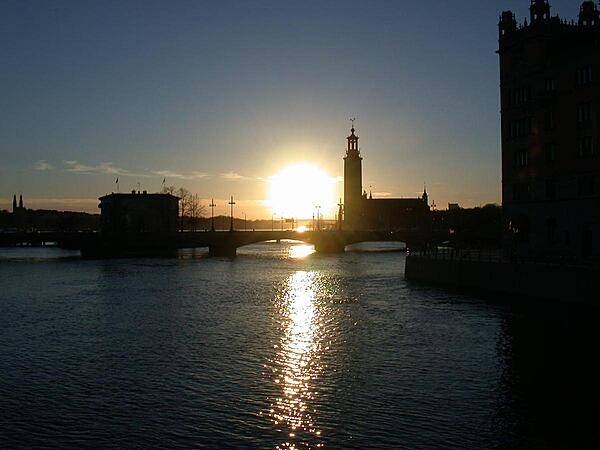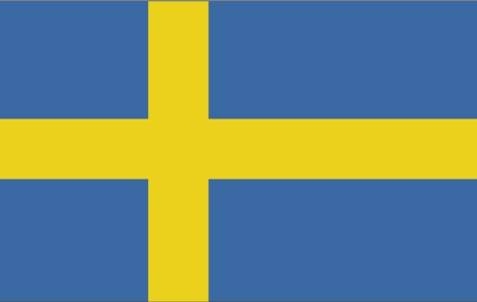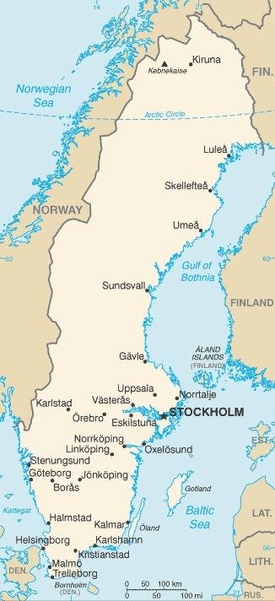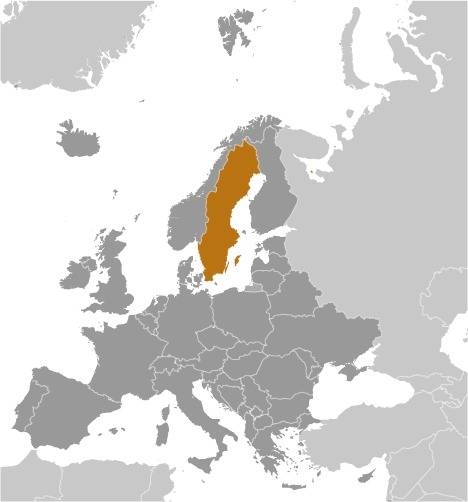Introduction
Background
A military power during the 17th century, Sweden has not participated in any war for two centuries. An armed neutrality was preserved in both World Wars. Since then, Sweden has pursued a successful economic formula consisting of a capitalist system intermixed with substantial welfare elements. Sweden joined the EU in 1995, but the public rejected the introduction of the euro in a 2003 referendum. The share of Sweden’s population born abroad increased from 11.3% in 2000 to 20% in 2021.
Visit the Definitions and Notes page to view a description of each topic.
Geography
Location
Northern Europe, bordering the Baltic Sea, Gulf of Bothnia, Kattegat, and Skagerrak, between Finland and Norway
Geographic coordinates
62 00 N, 15 00 E
Map references
Europe
Area - comparative
almost three times the size of Georgia; slightly larger than California
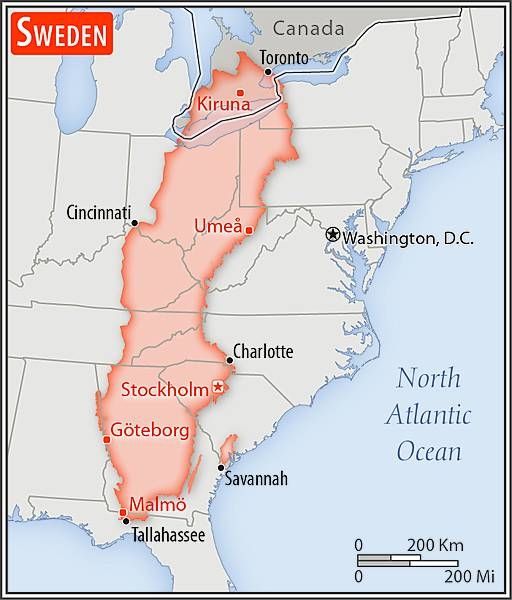
Land boundaries
total: 2,211 km
border countries (2): Finland 545 km; Norway 1,666 km
Coastline
3,218 km
Maritime claims
territorial sea: 12 nm (adjustments made to return a portion of straits to high seas)
exclusive economic zone: agreed boundaries or midlines
continental shelf: 200-m depth or to the depth of exploitation
Climate
temperate in south with cold, cloudy winters and cool, partly cloudy summers; subarctic in north
Terrain
mostly flat or gently rolling lowlands; mountains in west
Elevation
highest point: Kebnekaise South 2,100 m
lowest point: reclaimed bay of Lake Hammarsjon, near Kristianstad -2.4 m
mean elevation: 320 m
Natural resources
iron ore, copper, lead, zinc, gold, silver, tungsten, uranium, arsenic, feldspar, timber, hydropower
Land use
agricultural land: 7.5% (2018 est.)
arable land: 6.4% (2018 est.)
permanent crops: 0% (2018 est.)
permanent pasture: 1.1% (2018 est.)
forest: 68.7% (2018 est.)
other: 23.8% (2018 est.)
Irrigated land
519 sq km (2013)
Major lakes (area sq km)
fresh water lake(s): Vanern - 5,580 sq km; Vattern - 1,910 sq km; Malaren - 1,140 sq km
Population distribution
most Swedes live in the south where the climate is milder and there is better connectivity to mainland Europe; population clusters are found all along the Baltic coast in the east; the interior areas of the north remain sparsely populated
Natural hazards
ice floes in the surrounding waters, especially in the Gulf of Bothnia, can interfere with maritime traffic
Geography - note
strategic location along Danish Straits linking Baltic and North Seas; Sweden has almost 100,000 lakes, the largest of which, Vanern, is the third largest in Europe
People and Society
Nationality
noun: Swede(s)
adjective: Swedish
Ethnic groups
Swedish 80.3%, Syrian 1.9%, Iraqi 1.4%, Finnish 1.4%, other 15%
(2020 est.)note: data represent the population by country of birth; the indigenous Sami people are estimated to number between 20,000 and 40,000
Languages
Swedish (official)
major-language sample(s):
The World Factbook, den obestridliga källan för grundläggande information. (Swedish)
The World Factbook, the indispensable source for basic information.
note: Finnish, Sami, Romani, Yiddish, and Meankieli are official minority languages
Religions
Church of Sweden (Lutheran) 57.6%, other (includes Roman Catholic, Orthodox, Baptist, Muslim, Jewish, and Buddhist) 8.9%, none or unspecified 33.5% (2019 est.)
note: estimates reflect registered members of faith communities eligible for state funding (not all religions are state-funded and not all people who identify with a particular religion are registered members) and the Church of Sweden
Age structure
0-14 years: 17.71% (male 928,413/female 878,028)
15-24 years: 10.8% (male 569,082/female 532,492)
25-54 years: 39.01% (male 2,016,991/female 1,962,617)
55-64 years: 11.9% (male 610,521/female 603,795)
65 years and over: 20.59% (male 974,410/female 1,126,142) (2020 est.)
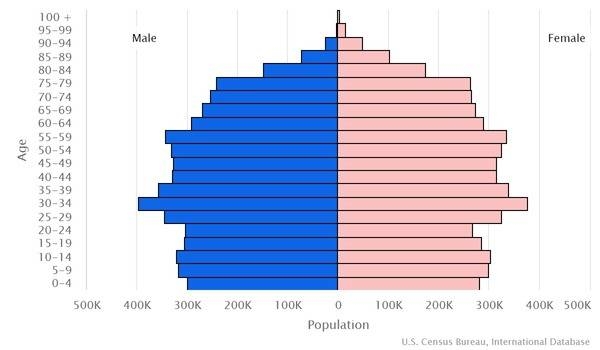
Dependency ratios
total dependency ratio: 60.8
youth dependency ratio: 28.5
elderly dependency ratio: 32.3
potential support ratio: 3.1 (2021 est.)
Median age
total: 41.1 years
male: 40.1 years
female: 42.1 years (2020 est.)
Population distribution
most Swedes live in the south where the climate is milder and there is better connectivity to mainland Europe; population clusters are found all along the Baltic coast in the east; the interior areas of the north remain sparsely populated
Urbanization
urban population: 88.7% of total population (2023)
rate of urbanization: 0.89% annual rate of change (2020-25 est.)
Major urban areas - population
1.700 million STOCKHOLM (capital) (2023)
Sex ratio
at birth: 1.06 male(s)/female
0-14 years: 1.06 male(s)/female
15-24 years: 1.1 male(s)/female
25-54 years: 1.04 male(s)/female
55-64 years: 1.02 male(s)/female
65 years and over: 0.69 male(s)/female
total population: 1.01 male(s)/female (2022 est.)
Mother's mean age at first birth
29.7 years (2020 est.)
Maternal mortality ratio
4 deaths/100,000 live births (2017 est.)
country comparison to the world: 175Infant mortality rate
total: 2.3 deaths/1,000 live births
male: 2.52 deaths/1,000 live births
female: 2.06 deaths/1,000 live births (2022 est.)
Life expectancy at birth
total population: 82.7 years
male: 80.94 years
female: 84.58 years (2022 est.)
Contraceptive prevalence rate
70.3% (2017)
note: percent of women aged 16-49
Drinking water source
improved: urban: 99.8% of population
rural: 99.7% of population
total: 99.8% of population
unimproved: urban: 0.2% of population
rural: 0.3% of population
total: 0.2% of population (2020 est.)
Current health expenditure
10.9% of GDP (2019)
Physicians density
7.09 physicians/1,000 population (2019)
Hospital bed density
2.1 beds/1,000 population (2018)
Sanitation facility access
improved: urban: 100% of population
rural: 100% of population
total: 100% of population
unimproved: urban: 0% of population
rural: 0% of population
total: 0% of population (2020 est.)
Alcohol consumption per capita
total: 7.1 liters of pure alcohol (2019 est.)
beer: 2.6 liters of pure alcohol (2019 est.)
wine: 3.4 liters of pure alcohol (2019 est.)
spirits: 1 liters of pure alcohol (2019 est.)
other alcohols: 0.1 liters of pure alcohol (2019 est.)
Tobacco use
total: 24% (2020 est.)
male: 29.8% (2020 est.)
female: 18.2% (2020 est.)
Literacy
total population: NA
male: NA
female: NA
School life expectancy (primary to tertiary education)
total: 20 years
male: 18 years
female: 21 years (2020)
Youth unemployment rate (ages 15-24)
total: 24.8%
male: 25.3%
female: 24.1% (2021 est.)
Environment
Environment - current issues
marine pollution (Baltic Sea and North Sea); acid rain damage to soils and lakes; air pollution; inappropriate timber harvesting practices
Environment - international agreements
party to: Air Pollution, Air Pollution-Heavy Metals, Air Pollution-Multi-effect Protocol, Air Pollution-Nitrogen Oxides, Air Pollution-Persistent Organic Pollutants, Air Pollution-Sulphur 85, Air Pollution-Sulphur 94, Air Pollution-Volatile Organic Compounds, Antarctic-Environmental Protection, Antarctic-Marine Living Resources, Antarctic Treaty, Biodiversity, Climate Change, Climate Change-Kyoto Protocol, Climate Change-Paris Agreement, Comprehensive Nuclear Test Ban, Desertification, Endangered Species, Environmental Modification, Hazardous Wastes, Law of the Sea, Marine Dumping-London Convention, Marine Dumping-London Protocol, Nuclear Test Ban, Ozone Layer Protection, Ship Pollution, Tropical Timber 2006, Wetlands, Whaling
signed, but not ratified: none of the selected agreements
Air pollutants
particulate matter emissions: 5.89 micrograms per cubic meter (2016 est.)
carbon dioxide emissions: 43.25 megatons (2016 est.)
methane emissions: 4.42 megatons (2020 est.)
Climate
temperate in south with cold, cloudy winters and cool, partly cloudy summers; subarctic in north
Land use
agricultural land: 7.5% (2018 est.)
arable land: 6.4% (2018 est.)
permanent crops: 0% (2018 est.)
permanent pasture: 1.1% (2018 est.)
forest: 68.7% (2018 est.)
other: 23.8% (2018 est.)
Urbanization
urban population: 88.7% of total population (2023)
rate of urbanization: 0.89% annual rate of change (2020-25 est.)
Revenue from forest resources
forest revenues: 0.21% of GDP (2018 est.)
country comparison to the world: 91Waste and recycling
municipal solid waste generated annually: 4.377 million tons (2015 est.)
municipal solid waste recycled annually: 1,416,835 tons (2015 est.)
percent of municipal solid waste recycled: 32.4% (2015 est.)
Major lakes (area sq km)
fresh water lake(s): Vanern - 5,580 sq km; Vattern - 1,910 sq km; Malaren - 1,140 sq km
Total water withdrawal
municipal: 955 million cubic meters (2017 est.)
industrial: 1.345 billion cubic meters (2017 est.)
agricultural: 75 million cubic meters (2017 est.)
Total renewable water resources
174 billion cubic meters (2017 est.)
Government
Country name
conventional long form: Kingdom of Sweden
conventional short form: Sweden
local long form: Konungariket Sverige
local short form: Sverige
etymology: name ultimately derives from the North Germanic Svear tribe, which inhabited central Sweden and is first mentioned in the first centuries A.D.
Government type
parliamentary constitutional monarchy
Capital
name: Stockholm
geographic coordinates: 59 20 N, 18 03 E
time difference: UTC+1 (6 hours ahead of Washington, DC, during Standard Time)
daylight saving time: +1hr, begins last Sunday in March; ends last Sunday in October
etymology: stock and holm literally mean "log" and "islet" in Swedish, but there is no consensus as to what the words refer to
Administrative divisions
21 counties (lan, singular and plural); Blekinge, Dalarna, Gavleborg, Gotland, Halland, Jamtland, Jonkoping, Kalmar, Kronoberg, Norrbotten, Orebro, Ostergotland, Skane, Sodermanland, Stockholm, Uppsala, Varmland, Vasterbotten, Vasternorrland, Vastmanland, Vastra Gotaland
Independence
6 June 1523 (Gustav VASA elected king of Sweden, marking the abolishment of the Kalmar Union between Denmark, Norway, and Sweden)
National holiday
National Day, 6 June (1983); note - from 1916 to 1982 this date was celebrated as Swedish Flag Day
Constitution
history: Sweden has four fundamental laws which together make up the Constitution: The Instrument of Government (several previous; latest 1974); The Act of Succession (enacted 1810; changed in 1937 and 1980); The Freedom of the Press Act (many previous; latest in 1949); The Fundamental Law on Freedom of Expression (adopted 1991)
amendments: proposed by Parliament; passage requires simple majority vote in two consecutive parliamentary terms with an intervening general election; passage also requires approval by simple majority vote in a referendum if Parliament approves a motion for a referendum by one third of its members; The Instrument of Government - amended several times, last in 2018; The Act of Succession - changed in 1937, 1980; The Freedom of the Press Act - amended several times, last in 2019; The Fundamental Law on Freedom of Expression - amended several times, last in 2018
Legal system
civil law system influenced by Roman-Germanic law and customary law
International law organization participation
accepts compulsory ICJ jurisdiction with reservations; accepts ICCt jurisdiction
Citizenship
citizenship by birth: no
citizenship by descent only: the father must be a citizen of Sweden; in the case of a child born out of wedlock, the mother must be a citizen of Sweden and the father unknown
dual citizenship recognized: no, unless the other citizenship was acquired involuntarily
residency requirement for naturalization: 5 years
Suffrage
18 years of age; universal
Executive branch
chief of state: King CARL XVI GUSTAF (since 15 September 1973); Heir Apparent Princess VICTORIA Ingrid Alice Desiree (daughter of the monarch, born 14 July 1977)
head of government: Prime Minister Ulf KRISTERSSON (since 18 October 2022); Deputy Prime Minister Ebba BUSCH (since 18 October 2022)
cabinet: Cabinet appointed by the prime minister
elections/appointments: the monarchy is hereditary; following legislative elections, the leader of the majority party or majority coalition usually becomes the prime minister
Legislative branch
description: unicameral Parliament or Riksdag (349 seats; 310 members directly elected in multi-seat constituencies by open party-list proportional representation vote and 39 members in "at-large" seats directly elected by open party-list proportional representation vote; members serve 4-year terms)
elections: last held on 11 September 2022
election results: percent of vote by party - S/SAP 30.3%, M 19.1%, SD 20.5%, C 6.7%, V 6.7%, KD 5.3%, L 4.6%, MP 5.1%, other 1.7%; seats by party - S/SAP 107, M 68, SD 73, C 24, V 24, KD 19, L 16, MP 18; composition as of mid-2022 - men 188, women 161, percent of women 46%
Judicial branch
highest court(s): Supreme Court of Sweden (consists of 16 justices, including the court chairman); Supreme Administrative Court (consists of 18 justices, including the court president)
judge selection and term of office: Supreme Court and Supreme Administrative Court justices nominated by the Judges Proposal Board, a 9-member nominating body consisting of high-level judges, prosecutors, and members of Parliament; justices appointed by the Government; following a probationary period, justices' appointments are permanent
subordinate courts: first instance, appellate, general, and administrative courts; specialized courts that handle cases such as land and environment, immigration, labor, markets, and patents
Political parties and leaders
Center Party (Centerpartiet) or C [Annie LOOF resigned on 15 September 2022]
Christian Democrats (Kristdemokraterna) or KD [Ebba BUSCH]
Green Party (Miljopartiet de Grona) or MP [Marta STEVENI and Per BOLUND]
Left Party (Vansterpartiet) or V [Nooshi DADGOSTAR]
Moderate Party (Moderaterna) or M [Ulf KRISTERSSON]
Sweden Democrats (Sverigedemokraterna) or SD [Jimmie AKESSON]
Swedish Social Democratic Party (Socialdemokraterna) or S/SAP [Magdalena ANDERSSON]
The Liberals (Liberalerna) or L [Johan PEHRSON]
International organization participation
ADB (nonregional member), AfDB (nonregional member), Arctic Council, Australia Group, BIS, CBSS, CD, CE, CERN, EAPC, EBRD, ECB, EIB, EITI (implementing country), EMU, ESA, EU, FAO, FATF, G-9, G-10, IADB, IAEA, IBRD, ICAO, ICC (national committees), ICCt, ICRM, IDA, IEA, IFAD, IFC, IFRCS, IGAD (partners), IHO, ILO, IMF, IMO, IMSO, Interpol, IOC, IOM, IPU, ISO, ITSO, ITU, ITUC (NGOs), MIGA, MINUSMA, MONUSCO, NC, NEA, NIB, NSG, OAS (observer), OECD, OPCW, OSCE, Paris Club, PCA, PFP, Schengen Convention, UN, UNCTAD, UNESCO, UNHCR, UNIDO, UNMISS, UNMOGIP, UNRWA, UN Security Council (temporary), UNSOM, UNTSO, UPU, Wassenaar Arrangement, WCO, WFTU (NGOs), WHO, WIPO, WMO, WTO, ZC
Diplomatic representation in the US
chief of mission: Ambassador Karin Ulrika OLOFSDOTTER (since 8 September 2017)
chancery: 2900 K Street NW, Washington, DC 20007
telephone: [1] (202) 467-2600
FAX: [1] (202) 467-2699
email address and website:
ambassaden.washington@gov.se
https://www.swedenabroad.se/en/embassies/usa-washington/
consulate(s) general: New York
Diplomatic representation from the US
chief of mission: Ambassador Erik D. RAMANATHAN (since 20 January 2022)
embassy: Dag Hammarskjolds Vag 31, SE-115 89 Stockholm
mailing address: 5750 Stockholm Place, Washington, DC 20521-5750
telephone: [46] (08) 783-53-00
FAX: [46] (08) 661-19-64
email address and website:
STKACSinfo@state.gov
https://se.usembassy.gov/
Flag description
blue with a golden yellow cross extending to the edges of the flag; the vertical part of the cross is shifted to the hoist side in the style of the Dannebrog (Danish flag); the colors reflect those of the Swedish coat of arms - three gold crowns on a blue field
National symbol(s)
three crowns, lion; national colors: blue, yellow
National anthem
name: "Du Gamla, Du Fria" (Thou Ancient, Thou Free)
lyrics/music: Richard DYBECK/traditional
note: in use since 1844; also known as "Sang till Norden" (Song of the North), is based on a Swedish folk tune; it has never been officially adopted by the government; "Kungssangen" (The King's Song) serves as the royal anthem and is played in the presence of the royal family and during certain state ceremonies
National heritage
total World Heritage Sites: 15 (13 cultural, 1 natural, 1 mixed)
selected World Heritage Site locales: Royal Domain of Drottningholm (c); Laponian Area (m); High Coast/Kvarken Archipelago (n); Birka and Hovgården (c); Hanseatic Town of Visby (c); Church Town of Gammelstad, Luleå (c); Naval Port of Karlskrona (c); Rock Carvings in Tanum (c); Engelsberg Ironworks (c); Mining Area of the Great Copper Mountain in Falun (c)
Economy
Economic overview
Sweden’s small, open, and competitive economy has been thriving and Sweden has achieved an enviable standard of living with its combination of free-market capitalism and extensive welfare benefits. Sweden remains outside the euro zone largely out of concern that joining the European Economic and Monetary Union would diminish the country’s sovereignty over its welfare system.
Timber, hydropower, and iron ore constitute the resource base of a manufacturing economy that relies heavily on foreign trade. Exports, including engines and other machines, motor vehicles, and telecommunications equipment, account for more than 44% of GDP. Sweden enjoys a current account surplus of about 5% of GDP, which is one of the highest margins in Europe.
GDP grew an estimated 3.3% in 2016 and 2017 driven largely by investment in the construction sector. Swedish economists expect economic growth to ease slightly in the coming years as this investment subsides. Global economic growth boosted exports of Swedish manufactures further, helping drive domestic economic growth in 2017. The Central Bank is keeping an eye on deflationary pressures and bank observers expect it to maintain an expansionary monetary policy in 2018. Swedish prices and wages have grown only slightly over the past few years, helping to support the country’s competitiveness.
In the short and medium term, Sweden’s economic challenges include providing affordable housing and successfully integrating migrants into the labor market.
Real GDP (purchasing power parity)
$524.75 billion (2020 est.)
$539.96 billion (2019 est.)
$532.67 billion (2018 est.)
note: data are in 2017 dollars
Real GDP growth rate
1.29% (2019 est.)
2.06% (2018 est.)
2.82% (2017 est.)
Real GDP per capita
$50,700 (2020 est.)
$52,500 (2019 est.)
$52,300 (2018 est.)
note: data are in 2017 dollars
GDP (official exchange rate)
$531.35 billion (2019 est.)
Inflation rate (consumer prices)
1.7% (2019 est.)
1.9% (2018 est.)
1.7% (2017 est.)
Credit ratings
Fitch rating: AAA (2004)
Moody's rating: Aaa (2002)
Standard & Poors rating: AAA (2004)
note: The year refers to the year in which the current credit rating was first obtained.
GDP - composition, by sector of origin
agriculture: 1.6% (2017 est.)
industry: 33% (2017 est.)
services: 65.4% (2017 est.)
GDP - composition, by end use
household consumption: 44.1% (2017 est.)
government consumption: 26% (2017 est.)
investment in fixed capital: 24.9% (2017 est.)
investment in inventories: 0.8% (2017 est.)
exports of goods and services: 45.3% (2017 est.)
imports of goods and services: -41.1% (2017 est.)
Agricultural products
wheat, milk, sugar beet, barley, potatoes, oats, rapeseed, pork, rye, triticale
Industries
iron and steel, precision equipment (bearings, radio and telephone parts, armaments), wood pulp and paper products, processed foods, motor vehicles
Labor force - by occupation
agriculture: 2%
industry: 12%
services: 86% (2014 est.)
Youth unemployment rate (ages 15-24)
total: 24.8%
male: 25.3%
female: 24.1% (2021 est.)
Population below poverty line
17.1% (2018 est.)
Gini Index coefficient - distribution of family income
28.8 (2017 est.)
25 (1992)
Household income or consumption by percentage share
lowest 10%: 3.4%
highest 10%: 24% (2012)
Budget
revenues: 271.2 billion (2017 est.)
expenditures: 264.4 billion (2017 est.)
Public debt
40.8% of GDP (2017 est.)
42.3% of GDP (2016 est.)
note: data cover general government debt and include debt instruments issued (or owned) by government entities other than the treasury; the data include treasury debt held by foreign entities; the data include debt issued by subnational entities, as well as intragovernmental debt; intragovernmental debt consists of treasury borrowings from surpluses in the social funds, such as for retirement, medical care, and unemployment; debt instruments for the social funds are not sold at public auctions
Fiscal year
calendar year
Current account balance
$22.339 billion (2019 est.)
$13.902 billion (2018 est.)
Exports
$240.08 billion (2020 est.) note: data are in current year dollars
$254.53 billion (2019 est.) note: data are in current year dollars
$254.25 billion (2018 est.) note: data are in current year dollars
Exports - partners
Germany 10%, Norway 9%, United States 8%, Denmark 7%, Finland 6%, United Kingdom 5%, Netherlands 5%, China 5% (2019)
Exports - commodities
cars and vehicle parts, packaged medicines, refined petroleum, broadcasting equipment, lumber (2019)
Imports
$217.68 billion (2020 est.) note: data are in current year dollars
$232.81 billion (2019 est.) note: data are in current year dollars
$241.53 billion (2018 est.) note: data are in current year dollars
Imports - partners
Germany 18%, Netherlands 9%, Denmark 7%, Norway 7%, China 6%, Finland 5%, Belgium 5%, Poland 5% (2019)
Imports - commodities
cars and vehicle parts, crude petroleum, refined petroleum, broadcasting equipment, computers (2019)
Reserves of foreign exchange and gold
$62.22 billion (31 December 2017 est.)
$59.39 billion (31 December 2016 est.)
Debt - external
$911.317 billion (2019 est.)
$1,012,171,000,000 (2018 est.)
Exchange rates
Swedish kronor (SEK) per US dollar -
8.49085 (2020 est.)
9.52915 (2019 est.)
9.01895 (2018 est.)
8.4335 (2014 est.)
6.8612 (2013 est.)
Energy
Electricity access
electrification - total population: 100% (2020)
Electricity
installed generating capacity: 43.499 million kW (2020 est.)
consumption: 124.609 billion kWh (2020 est.)
exports: 36.824 billion kWh (2020 est.)
imports: 11.827 billion kWh (2020 est.)
transmission/distribution losses: 10.434 billion kWh (2020 est.)
Electricity generation sources
fossil fuels: 1% of total installed capacity (2020 est.)
nuclear: 29.5% of total installed capacity (2020 est.)
solar: 0.7% of total installed capacity (2020 est.)
wind: 17.2% of total installed capacity (2020 est.)
hydroelectricity: 44.7% of total installed capacity (2020 est.)
tide and wave: 0% of total installed capacity (2020 est.)
geothermal: 0% of total installed capacity (2020 est.)
biomass and waste: 6.9% of total installed capacity (2020 est.)
Coal
production: 1.07 million metric tons (2020 est.)
consumption: 3.328 million metric tons (2020 est.)
exports: 24,000 metric tons (2020 est.)
imports: 2.144 million metric tons (2020 est.)
proven reserves: 1 million metric tons (2019 est.)
Petroleum
total petroleum production: 10,600 bbl/day (2021 est.)
refined petroleum consumption: 295,800 bbl/day (2019 est.)
crude oil and lease condensate exports: 0 bbl/day (2018 est.)
crude oil and lease condensate imports: 403,200 bbl/day (2018 est.)
crude oil estimated reserves: 0 barrels (2021 est.)
Refined petroleum products - production
413,200 bbl/day (2017 est.)
country comparison to the world: 36Natural gas
production: 0 cubic meters (2021 est.)
consumption: 1,275,785,000 cubic meters (2020 est.)
exports: 34.886 million cubic meters (2020 est.)
imports: 1,310,671,000 cubic meters (2020 est.)
proven reserves: 0 cubic meters (2021 est.)
Carbon dioxide emissions
48.144 million metric tonnes of CO2 (2019 est.)
from coal and metallurgical coke: 7.38 million metric tonnes of CO2 (2019 est.)
from petroleum and other liquids: 38.406 million metric tonnes of CO2 (2019 est.)
from consumed natural gas: 2.359 million metric tonnes of CO2 (2019 est.)
Energy consumption per capita
210.882 million Btu/person (2019 est.)
country comparison to the world: 21Communications
Telephones - fixed lines
total subscriptions: 1,478,610 (2020 est.)
subscriptions per 100 inhabitants: 15 (2020 est.)
Telephones - mobile cellular
total subscriptions: 12,895,900 (2019)
subscriptions per 100 inhabitants: 128.49 (2019)
Telecommunication systems
general assessment: Sweden’s telecom market includes mature mobile and broadband sectors which have been stimulated by the progressive investment of the main telcos in developing new technologies; the country retains one of the best developed LTE infrastructures in the region, while its MNOs have benefited from the January 2021 auction of spectrum in the 3.5GHz band which will enable them to expand services nationally; the country also has one of the highest fiber broadband penetration rates in Europe; the focus of FttP is aimed at fulfilling the government’s target of providing a 1Gb/s service to 98% of the population by 2025; the methodology to achieve this has rested on regulatory measures supported by public funds, as well as on the auction of spectrum in different bands; in the fixed-line broadband segment, the number of DSL subscribers is falling steadily as customers continue to migrate to fiber networks; there is also competition from HFC infrastructure, offering fiber-based broadband and investing in services based on the DOCSIS3.1 standard; this report assesses key aspects of the Swedish telecom market, providing data on fixed network services and profiling the main players; it also reviews the key regulatory issues, including interconnection, local loop unbundling, number portability, carrier preselection and NGN open access; the report also analyses the mobile market, providing data on network operators and their strategies in a highly competitive environment; in addition, the report considers the fixed and fixed-wireless broadband markets, including analyses of market dynamics and the main operators, as well as providing subscriber forecasts (2021)
domestic: fixed-line just over 16 per 100 and mobile-cellular roughly 128 per 100; coaxial and multiconductor cables carry most of the voice traffic; parallel microwave radio relay systems carry some additional telephone channels (2020)
international: country code - 46; landing points for Botina, SFL, SFS-4, Baltic Sea Submarine Cable, Eastern Light, Sweden-Latvia, BCS North-Phase1, EE-S1, LV-SE1, BCS East-West Interlink, NordBalt, Baltica, Denmark-Sweden-15,-17,-18, Scandinavian Ring -North,-South, IP-Only Denmark-Sweden, Donica North, Kattegate-1,-2, Energinet Laeso-Varberg and GC2 submarine cables providing links to other Nordic countries and Europe; satellite earth stations - 1 Intelsat (Atlantic Ocean), 1 Eutelsat, and 1 Inmarsat (Atlantic and Indian Ocean regions); note - Sweden shares the Inmarsat earth station with the other Nordic countries (Denmark, Finland, Iceland, and Norway) (2019)
note: the COVID-19 pandemic continues to have a significant impact on production and supply chains globally; since 2020, some aspects of the telecom sector have experienced a downturn, particularly in mobile device production; progress toward 5G implementation has resumed, as well as upgrades to infrastructure; consumer spending on telecom services has increased due to the surge in demand for capacity and bandwidth; the crucial nature of telecom services as a tool for work and school from home is still evident, and the spike in this area has seen growth opportunities for development of new tools and increased services
Broadcast media
publicly owned TV broadcaster operates 2 terrestrial networks plus regional stations; multiple privately owned TV broadcasters operating nationally, regionally, and locally; about 50 local TV stations; widespread access to pan-Nordic and international broadcasters through multi-channel cable and satellite TV; publicly owned radio broadcaster operates 3 national stations and a network of 25 regional channels; roughly 100 privately owned local radio stations with some consolidating into near national networks; an estimated 900 community and neighborhood radio stations broadcast intermittently
Internet users
total: 9,835,769 (2020 est.)
percent of population: 95% (2020 est.)
Broadband - fixed subscriptions
total: 4,179,574 (2020 est.)
subscriptions per 100 inhabitants: 41 (2020 est.)
Transportation
National air transport system
number of registered air carriers: 11 (2020)
inventory of registered aircraft operated by air carriers: 316
Airports - with paved runways
total: 149
over 3,047 m: 3
2,438 to 3,047 m: 12
1,524 to 2,437 m: 75
914 to 1,523 m: 22
under 914 m: 37 (2021)
Airports - with unpaved runways
total: 82
914 to 1,523 m: 5
under 914 m: 77 (2021)
Heliports
2 (2021)
Pipelines
1626 km gas (2013)
Railways
total: 14,127 km (2016)
standard gauge: 14,062 km (2016) 1.435-m gauge (12,322 km electrified)
narrow gauge: 65 km (2016) 0.891-m gauge (65 km electrified)
Roadways
total: 573,134 km (2016) (includes 2,050 km of expressways)
paved: 140,100 km (2016)
unpaved: 433,034 km (2016)
note: includes 98,500 km of state roads, 433,034 km of private roads, and 41,600 km of municipal roads
Merchant marine
total: 370
by type: general cargo 49, oil tanker 22, other 299 (2021)
Ports and terminals
major seaport(s): Brofjorden, Goteborg, Helsingborg, Karlshamn, Lulea, Malmo, Stockholm, Trelleborg, Visby
LNG terminal(s) (import): Brunnsviksholme, Lysekil
Transportation - note
Sweden operates four PC 3 or 4 class medium icebreakers in the Baltic Sea
note - PC indicates a Polar Class vessel: PC 3 - year-round operation in second-year ice which may include multi-year ice inclusions (ice thickness up to 2.5 m); PC 4 - year-round operation in thick first-year ice which may include old ice inclusions (ice thickness up to 120 cm)
Military and Security
Military and security forces
Swedish Armed Forces (Forsvarsmakten): Army, Navy, Air Force, Home Guard (2022)
Military expenditures
1.3% of GDP (2021 est.)
1.2% of GDP (2020)
1.1% of GDP (2019) (approximately $6.78 billion)
1% of GDP (2018) (approximately $6.26 billion)
1% of GDP (2017) (approximately $6.04 billion)
Military and security service personnel strengths
approximately 15,000 continuous service/full-time troops (7,000 Army; 3,000 Navy; 3,000 Air Force; 2,000 other, including staff, logistics, support, medical, cyber, intelligence, etc); approximately 21,000 Home Guard; approximately 12,000 temporary service personnel (2022)
note: Swedish Armed Forces' (SAF) personnel are divided into continuously serving (full-time) and temporary service troops (part-timers who serve periodically and have another main employer or attend school); additional personnel have signed service agreements with the SAF and mostly serve in the Home Guard; the SAF also has about 9,000 civilian employees
Military equipment inventories and acquisitions
the inventory of the SAF is comprised of domestically-produced and imported Western weapons systems; since 2010, the US is the leading supplier of military hardware to Sweden; Sweden's defense industry produces a range of air, land, and naval systems (2021)
Military service age and obligation
18-47 years of age for male and female voluntary military service; service obligation: 7.5 months (Army), 7-15 months (Navy), 8-12 months (Air Force); after completing initial service, soldiers have a reserve commitment until age 47; compulsory military service, abolished in 2010, was reinstated in January 2018; conscription is selective, includes both men and women (age 18), and requires 9-12 months of service (2022)
note 1: Sweden conscripts about 5,500 men and women each year
note 2: as of 2021, women made up about 11% of the military's full-time personnel
Military deployments
approximately 200 Mali (MINUSMA) (2022)
Military - note
Sweden maintains a policy of military non-alignment, but cooperates with NATO and regional countries; it joined NATO’s Partnership for Peace program in 1994 and has contributed to NATO-led missions, including those in Afghanistan, Iraq, and Kosovo; Sweden applied for NATO membership in May 2022
the Swedish military cooperates closely with the military forces of other Nordic countries through the Nordic Defense Cooperation (NORDEFCO), which consists of Denmark, Finland, Iceland, Norway, and Sweden; areas of cooperation include armaments, education, human resources, training and exercises, and operations; NORDEFCO was established in 2009
Sweden is a signatory of the EU’s Common Security and Defense Policy and contributes to CSDP missions and operations (2022)
Terrorism
Terrorist group(s)
Islamic State of Iraq and ash-Sham (ISIS)
note: details about the history, aims, leadership, organization, areas of operation, tactics, targets, weapons, size, and sources of support of the group(s) appear(s) in Appendix-T
Transnational Issues
Disputes - international
none identified
Refugees and internally displaced persons
refugees (country of origin): 114,995 (Syria), 28,744 (Afghanistan), 26,911 (Eritrea), 11,574 (Somalia), 11,153 (Iraq), 7,516 (Iran) (2020); 49,789 (Ukraine) (as of 20 December 2022)
stateless persons: 50,098 (mid-year 2021); note - the majority of stateless people are from the Middle East and Somalia
